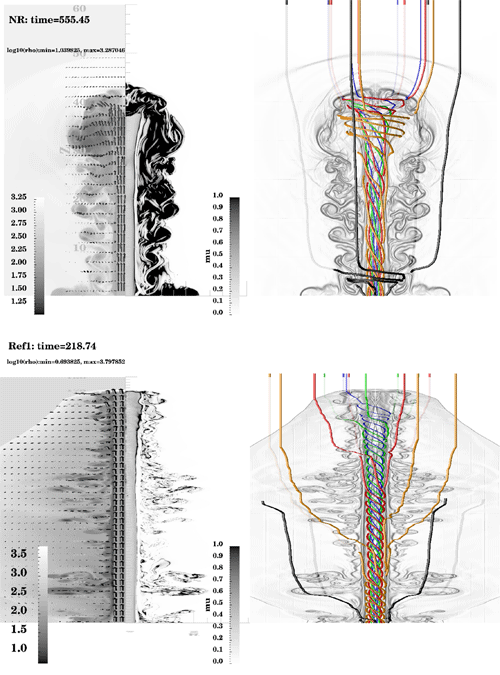Highlights - Volume 486-3 (August II 2008)
- Details
- Published on 10 July 2008
| HIGHLIGHTS: this week in A&A |
Volume 486-3 (August II 2008)
| In section 2. Astrophysical processes “Extragalactic jets with helical magnetic fields: relativistic MHD simulations”, by R. Keppens, Z. Meliani, B. van der Holst, and F. Casse, A&A 486, p. 663 This paper presents simulations of axisymmetric magnetic jets using a new adaptive mesh refinement (ARM) scheme for relativistic MHD. It shows the evolution of helical internal fields and their effect on the stability and propagation of the light jets in density gradients and contrasts. The jets are injected with helical internal fields, and the evolution of a toroidal structure, along with vortex shedding at the boundary, is followed. A strong self-confinement is obtained from the backflow in the cocoon surrounding the jet, and in the nonrelativistic case, the axial field is compressed. The jets are more stable and propagate farther. Detailed evolution of the jet magnetic field is shown, especially the generation of toroidal fields from the increased stability of the jet allows for longer propagation before disruption. For the strongly relativistic case, internal shocks further accelerate the jet and create vortex structures that are the possible origin of later turbulence, but this will only be resolved by a full 3D model. The jets display structures similar to those seen in FR II sources. |
|
| In section 4. Extragalactic astronomy “Simulating the mass-metallicity relation from z~1”, by M. Mouhcine, B.K. Gibson, A. Renda, and D. Kawata, A&A 486, p. 711 From a grid of galaxy models, the authors tried to reproduce the observed relations between mass, metallicity, and age in galaxies for a better understanding of how the star formation rate evolves in galaxies, across the Hubble time. Using N-body/hydrodynamical simulations within the concordance model, they predict galaxy chemical evolution. The observed relation between stellar mass and total mass is reproduced by the simulations, as is the relation between mass and metallicity. There is, however, no relation between stellar age and stellar mass, which cannot explain the younger population in lower mass galaxies. A solution could be that the assumed supernovae feedback is not strong enough. |
© Astronomy & Astrophysics 2008



